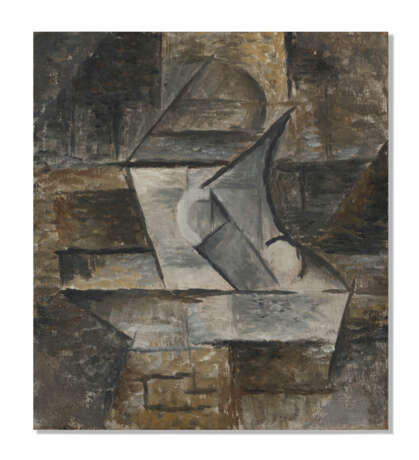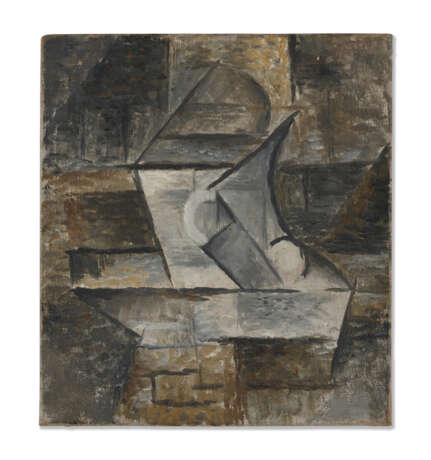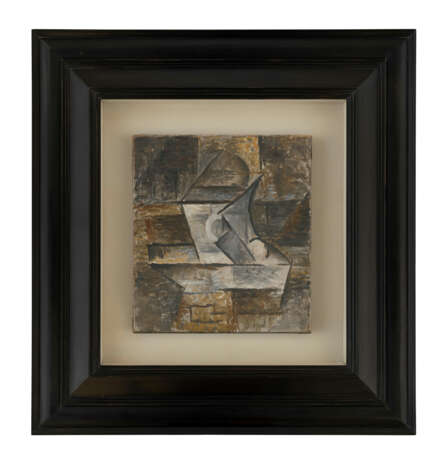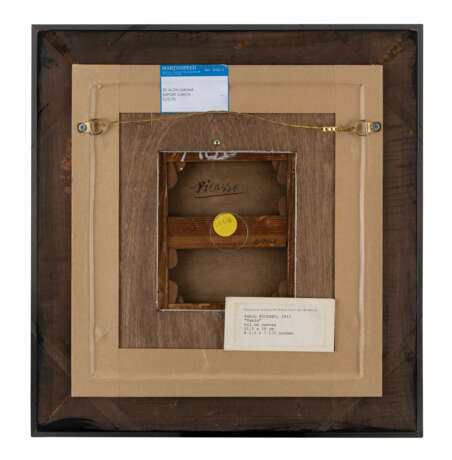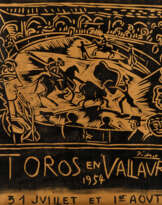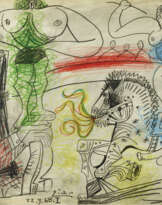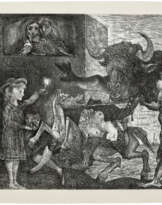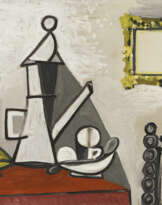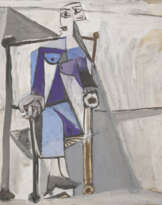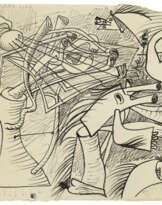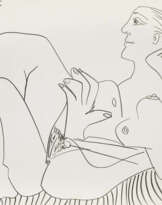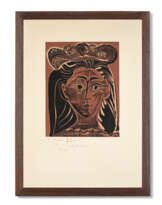ID 1053084
Lot 308 | Pablo Picasso (1881-1973)
Estimate value
€ 700 000 – 1 000 000
La Table
signé ‘Picasso’ (au revers)
huile sur toile
21.5 x 19 cm.
Peint au printemps 1911
signed 'Picasso' (on the reverse)
oil on canvas
8 ½ x 7 ½ in.
Painted in Spring 1911
Provenance
Jacques Doucet, Paris (probablement acquis dans les années 1920).
Collection particulière, Paris; vente, Christie, Manson & Woods, Londres, 3 juillet 1973, lot 59.
Vente, Sotheby’s, Londres, 3 décembre 1985, lot 42.
Stanley J. Seeger, États-Unis; sa vente, Sotheby’s, New York, 4 novembre 1993, lot 422.
Marlborough Galleries, Londres.
Alon Zakaim, Londres (acquis auprès de celle-ci en 2014).
Thomas Ammann Fine Art AG, Zurich (acquis auprès de celui-ci en 2015).
Galerie Thomas Salis, Salzbourg.
Acquis auprès de celle-ci par le propriétaire actuel en 2015.
Literature
P. Daix et J. Rosselet, Picasso, The Cubist years, 1907-1916, A Catalogue Raisonné of the Paintings and Related Works, Londres, 1979, p. 265, no. 402 (illustré à l'envers).
J. Palau i Fabre, Picasso Cubisme, 1907-1917, Barcelone, 1998, p. 503, no. 537 (illustré à l'envers, p. 192; daté 'été 1910').
Further details
Picasso a peint Table vers 1910-11, au cours de son aventure héroïque du cubisme analytique, ce langage pictural radicalement nouveau par lequel lui et Georges Braque démantelèrent toutes les traditions de représentation existantes, se rapprochant le plus possible de l'abstraction pure. Depuis le printemps 1910 et l'été passé à Cadaqués, le cubisme de Picasso est devenu de plus en plus audacieusement non naturaliste. Le treillis diagonal de 1909 a cédé la place à une armature de plans rectilignes superposés, nuancés de clair à foncé, qui évoquent à la fois la figure et le sol dans une relation ambiguë, en perpétuel mouvement, éliminant la dernière trace d'espace projectif. Les objets ne sont plus des masses discrètes et sculpturales, mais des volumes ouverts, dont les facettes sont écartées et réarrangées en briques discontinues et dématérialisées.
Dans ce tableau, Picasso rend les formes d'une table par un assemblage de formes géométriques, tout en donnant un sens de substance au fond chatoyant par l'application de touches de peinture dans une palette délibérément restreinte de gris, d'ocre, de noir, et d'éclats de blanc. La table semble être placée à un angle légèrement oblique, ce qui engendre un rythme sur la toile et évite la rigidité des compositions plus purement rectilignes. Le rendu inhabituel de la table désoriente le spectateur dans l'espace, mais les angles de la table sont reconnaissables et empêchent le tableau de perdre tout contact avec la réalité visuelle. Pourtant, à peine un fragment tangible semble-t-il émerger de la structure abstraite qu'il est à nouveau absorbé par l'ensemble mystérieux et insaisissable. ‘Ce va-et-vient’, écrit Cowling, ‘confère aux objets un aspect hallucinatoire, semblable à un mirage, qui nous amène à remettre en question nos impressions momentanées, à penser à d'autres interprétations, à nous demander si d'autres spectateurs verront ce que nous croyons avoir vu’ (Elizabeth Cowling, Picasso: Style and Meaning, London, 2002, p. 225).
Les perspectives fracturées à partir desquelles cette vue multiforme de la table a été montrée introduisent certaines des notions scientifiques et mathématiques qui circulaient à l'époque, y compris la notion de quatrième dimension, incluant en quelque sorte le temps dans une représentation bidimensionnelle d'objets de nature morte. Picasso niera plus tard tout intérêt particulier pour les mathématiques et la science de l'époque, et pourtant Josep Pla, journaliste et écrivain espagnol, se souviendra plus tard que Picasso ‘parlait beaucoup à l'époque de la quatrième dimension et qu'il transportait les livres de mathématiques d'Henri Poincaré’ (cité dans M. McCully, ed., A Picasso Anthology : Documents, Criticism, Reminiscences, Princeton, 1997, p. 69). Mais pour Picasso, les règles et les restrictions n'étaient jamais aussi intéressantes que les idées, et il n'était pas rigoureusement scientifique dans son cubisme analytique, conservant plutôt une grande partie de la crudité, de l'angularité et de l'intérêt dans la représentation de ces objets d'une nouvelle manière complète.
L'ami de Picasso, le poète Guillaume Apollinaire, a touché au cœur de la force motrice lorsqu'il a expliqué le cubisme en écrivant : ‘Tout le monde doit convenir qu'une chaise, de quelque côté qu'on la regarde, ne cesse jamais d'avoir quatre pieds, un siège et un dossier, et que, si on lui enlève un de ces éléments, on lui enlève une partie importante. Et les Primitifs ont peint une ville non pas telle que les gens du premier plan auraient pu la voir, mais telle qu'elle était en réalité : c'est-à-dire complète, avec ses portes, ses rues et ses tours. Un grand nombre de nouveautés introduites dans les tableaux de ce genre témoignent chaque jour de cette qualité humaine et poétique’ (G. Apollinaire, cité dans E.F. Fry, ed., Cubism, Londres, 1969, p. 113).
À cette époque, Picasso et Braque sont les grands pionniers de cette nouvelle méthode de vision et de représentation du monde. Ils ont cherché un langage visuel qui combine l'ordre et la science de l'ère moderne avec la vérité intemporelle des objets représentés, créant des archétypes reconnaissables, exploitant une notion de la réalité des objets au-delà de leur simple apparence. Les deux artistes ont créé le cubisme en tandem, comme en témoignent les similitudes entre certaines de leurs œuvres.
Table a probablement été acquise dès les années 1920 par Jacques Doucet (1853-1929), le grand couturier qui a habillé des actrices et des femmes célèbres dans le monde entier, telles que Sarah Bernhardt, Réjane, Liane de Pougy, La Belle Otéro. Il fut également un important mécène et collectionneur d'art, se concentrant d'abord sur l'art du XVIIIe siècle (l'un des chefs-d'œuvre de sa collection est La Bulle de Savon de Chardin), puis soutenant la scène littéraire et artistique contemporaine de son époque, achetant des œuvres de Sisley, Manet, Cézanne, Van Gogh, Matisse, Miro, Picabia, et il fut le premier propriétaire des Demoiselles d'Avignon de Picasso, en 1924.
Picasso painted Table circa 1910-11, during his fraught, heroic journey of Analytical Cubism, the radically new pictorial language by which he and Georges Braque dismantled every existing tradition of representation, coming as close as they ever would to pure abstraction. Beginning in spring of 1910 and gaining intensity during the summer at Cadaqués, Picasso’s Cubism had become increasingly, daringly non-naturalistic. The diagonal latticework of 1909 gave way to an armature of overlapping, rectilinear planes, shaded from light to dark, that conjure up both figure and ground in an ambiguous, ever-shifting relationship, eliminating the last trace of projective space. Objects are no longer discrete, sculptural masses, but now open volumes, their facets pried apart and rearranged into discontinuous, dematerialized bricks.
In the present painting, Picasso renders the shapes of a table through an assemblage of geometric forms, while lending a sense of substance to the shimmering background through an application of dabs of paint in the deliberately restricted palette of grey, ochre, black, and flashes of white. The table appears to be positioned at a slightly oblique angle, creating a rhythm across the canvas and avoiding the rigidity of the more purely rectilinear compositions. The unusual rendering of the table disorients the viewer in space, yet, the table’s angles are recognizable and prevent the painting from losing all contact with visual reality. Yet no sooner does a tangible fragment seem to emerge from the abstract structure than it is absorbed back into the mysterious, elusive whole. “This coming in and out of focus,” Cowling has written, “lends the objects an hallucinatory, mirage-like aspect, leading one to question one’s momentary impressions, to think of alternative interpretations, to wonder whether other spectators will see what one believes one has seen” (Elizabeth Cowling, Picasso, Style and Meaning, London, 2002, p. 225).
The fractured perspectives from which this multifaceted view of the table has been shown introduces some of the scientific and mathematical notions that were circulating at the time, including the notion of the fourth dimension, somehow including time into a two-dimensional representation of still-life objects. Picasso would later deny any particular interest in the mathematics and science of the age, and yet Josep Pla, a Spanish journalist and writer, would later recall that Picasso ‘used to talk a lot then about the fourth dimension and he carried about the mathematics books of Henri Poincaré’ (quoted in M. McCully, ed., A Picasso Anthology, Documents, Criticism, Reminiscences, Princeton, 1997, p. 69). But for Picasso, rules and restrictions were never as interesting as ideas, and he was not rigorously scientific in his Analytical Cubism, instead retaining much of the rawness, angularity, and interest in the representation of these objects in a new complete manner.
Picasso's friend, the poet Guillaume Apollinaire, cut to the heart of the driving force when he explained Cubism by writing: ‘Everyone must agree that a chair, from whichever side it is viewed, never ceases to have four legs, a seat and a back, and that, if it is robbed of one of these elements, it is robbed of an important part. And the Primitives painted a town not as the people in the foreground would have been able to see it, but as it was in reality: that is, complete, with its gates, streets and towers. A great many novelties that have been introduced into pictures of this kind bear witness daily to this human and poetical quality’ (G. Apollinaire, quoted in E.F. Fry, ed., Cubism, London, 1969, p. 113).
During this time, Picasso and Braque were the great pioneers of this new method of viewing and depicting the world. They sought a visual language that combined the order and science of the modern age with the timeless truth of the objects depicted, creating archetypes that are recognizable, harnessing a notion of the reality of the objects beyond their mere appearance. The pair created Cubism in tandem, as can be seen in the similarities between some of their works.
Table was most probably acquired as early as the 1920s by Jacques Doucet (1853-1929), the great haute couture fashion designer who dressed famous actresses and women around the world, such as Sarah Bernhardt, Réjane, Liane de Pougy, La Belle Otéro. He was also an important art patron and collector, initially focusing on 18th century art (one of the masterpieces of his collection was Chardin’s La Bulle de Savon) but then shifting to supporting the contemporary literary and art scene of his time, buying works by Sisley, Manet, Cézanne, Van Gogh, Matisse, Miro, Picabia, and he was the first owner of Picasso’s Demoiselles d’Avignon in 1924.
| Artist: | Pablo Picasso (1881 - 1973) |
|---|---|
| Applied technique: | Oil on canvas |
| Auction house category: | Paintings |
| Artist: | Pablo Picasso (1881 - 1973) |
|---|---|
| Applied technique: | Oil on canvas |
| Auction house category: | Paintings |
| Address of auction |
CHRISTIE'S 9 Avenue Matignon 75008 Paris France | ||||||||||||||
|---|---|---|---|---|---|---|---|---|---|---|---|---|---|---|---|
| Preview |
| ||||||||||||||
| Phone | +33 (0)1 40 76 85 85 | ||||||||||||||
| Fax | +33 (0)1 40 76 85 86 | ||||||||||||||
| Conditions of purchase | Conditions of purchase | ||||||||||||||
| Shipping |
Postal service Courier service pickup by yourself | ||||||||||||||
| Payment methods |
Wire Transfer | ||||||||||||||
| Business hours | Business hours
|
